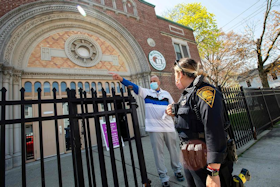|
Democrats Turn a Blind Eye to Connecticut’s Juvenile Crime Wave
The state desperately needs a special session of
the Legislature to address it, but Gov. Lamont refuses.
A juvenile crime wave is
breaking across Connecticut. Tragically, children have been both victims and
perpetrators.
 Residents,
chiefs of police, municipal leaders and community activists across the state are
begging Democratic Gov. Ned Lamont to address the problem by calling the
Democrat-dominated Legislature into special session. To date, these requests
have been ignored, with deadly results. Residents,
chiefs of police, municipal leaders and community activists across the state are
begging Democratic Gov. Ned Lamont to address the problem by calling the
Democrat-dominated Legislature into special session. To date, these requests
have been ignored, with deadly results.
&uuid=(email))
Hartford has seen more than 30 homicides this year, making 2020 one of the
deadliest years on record in Connecticut’s capital city. In April a 3-year-old
boy was shot and killed in a car by offenders who were themselves only 16 and
19. In neighboring New Britain, a 17-year-old with 13 prior arrests stole a car
and struck and killed a jogger in June. In a Danbury mall in August, a
14-year-old in a dispute with other teens shot an innocent bystander—a
15-year-old girl.
Bridgeport, the state’s largest city, has seen more than
10,000 incidents of shots
fired so far this year,
twice the number for all of 2020. Gun violence is “everywhere” in Connecticut, a
neighbor of the victims told the Connecticut Post.
Connecticut’s Democratic politicians consistently try to evade responsibility
for the violence by pointing to national trends. They ignore the residents,
law-enforcement officials and even the parents of juvenile offenders who are
begging them to do something to help end the violence. After recent shootings
that involved 10- and 14-year-old boys, Waterbury police chief Fernando Spagnolo
urged elected leaders to take action: “We need some help from the legislators.”
Even Neil O’Leary, Waterbury’s
Democratic mayor,
argued that Connecticut’s
juvenile criminal justice laws
have “swung too far to the left,”
becoming so permissive that officers can no longer do their jobs. “There is such
a lack of accountability for juveniles in the state of Connecticut right now
that it’s dangerous,” he said. “People are dying.”
The law-enforcement officers who are working to keep violent offenders off the
streets are right to feel that many state officials are working against them. In
2007, the state increased the age of juvenile court jurisdiction in Connecticut
to 18 from 16. Former Gov. Dannel Malloy, a Democrat, sought
to go even further, treating 20-year-old offenders as juveniles. In 2018 Mr.
Malloy signed a law mandating that juveniles be held in custody for no more than
six hours.
The Democrats who control Hartford have stonewalled calls for a special session
to address the increase in juvenile crime.
Connecticut Republicans have offered a set of reforms that include
round-the-clock Global Positioning System monitoring of youths charged with
violent crimes and repeat offenders awaiting trial. Currently such monitoring
can only be done during daylight hours. Other recommendations include allowing
police 24-hour access to juvenile records—currently they must wait for court to
open in the morning while those six hours of custody tick away—and requiring
fingerprinting of juveniles arrested on felony or Class A misdemeanor charges
involving sexual assault or loss of life. Early intervention by the Department
of Children and Families, funding for summer jobs programs for at-risk
communities, and better coordination between service providers and young
offenders would help reduce recidivism and keep communities safer.
Democrats insist that Republicans are painting a picture of Connecticut cities
overrun by crime for their own crass political purposes. But the inexcusable
crimes occurring almost daily tell a different story. Brushing off an increase
in violent crime as part of a national trend or somehow the fault of the
pandemic is simply not acceptable.
wsj.com
|